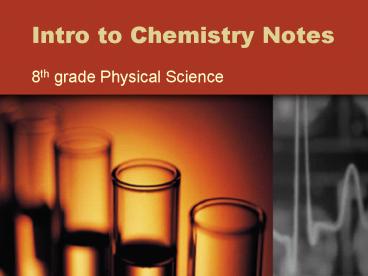Intro to Chemistry Notes - PowerPoint PPT Presentation
1 / 11
Title:
Intro to Chemistry Notes
Description:
Intro to Chemistry Notes 8th grade Physical Science Matter- Something that has mass and volume The building blocks are atoms/elements Element: Pure substance that ... – PowerPoint PPT presentation
Number of Views:157
Avg rating:3.0/5.0
Title: Intro to Chemistry Notes
1
Intro to Chemistry Notes
- 8th grade Physical Science
2
Matter-
- Something that has mass and volume
- The building blocks are atoms/elements
- Element Pure substance that cannot broken down
any more. - Nucleus of atom composed of P and Neu. E- on
the outside of nucleus - Atoms Basic particle from which all elements
are made.
Nucleus of atom composed of P and Neu. E- on the
outside of the nucleus
3
More about matter
- Protons () charge particle in the nucleus of
atom. (approx. ½ of mass of atom) - Neutron (0) charged particle in the nucleus of
atom. (approx. ½ mass of most atoms) - Electrons (-) charged particles outside nucleus
of atom (mini. mass)
4
States of Matter-
- Solid, Liquid, Gas, Plasma
- Solid Definite Shape volume. particles
Arranged closely together - Liquids Definite Volume, no shape. particles
arranged closely and are free to move - Gases No definite shape or volume and move
freely - Plasma High temps atoms to be stripped of its
electrons
5
Conservation of Mass and Energy
- The law states that matter is neither created
nor destroyed in any chemical or physical change - Aka the Law of Conservation of Matter
6
Properties of Matter-
- Physical Properties
- Ability to see changes in a substance without
changing it into another substance. - Chemical Properties
- Ability to change a substance into another
substance.
7
Physical Properties-
- Example H20 (liquid, gas, solid), etc.
- Melt point, freezing point, color, density,
solubility, conductivity, magnetism, malleability - Do not react with other substances mixtures.
- Mixtures made of 2 or more elements or
compounds not chem. combined - Heterogeneous Mix See diff. parts
- Homogeneous Mix Cannot see diff. parts.
8
Chemical Properties-
- Change in physical properties
- Color change, gas release
- Ability to react with chemicals to form new
chemicals - Ex Combustion, Electrolysis, Oxidation,
Tarnishing
9
Chemical Bonding-
- Chemical Bond attraction btw 2 atoms to
molecules (2 or more atoms bonded molecule) - Compound Molecule (change in physical props. Of
in individual atoms)
10
Periodic Table-
- Mendeleev Discovered patterns of props.
Appeared when he arranged elements in order of
increasing atomic mass - Prop of elements can be predicted from its
location on periodic table
http//www.corrosionsource.com/handbook/periodic/
11
More on the Periodic Table
- Periods Horizontal Rows
- (Left to Right) Reactive Metal, less reactive
metals, metalloids, nonmetals. - Groups/Families element that share similar
characteristics. - Elemental Squares Info Atomic , Chemical
Symbol, Element Name, Atomic Mass. - Concept Map
- Valence E- determine the Periodic Group












![Welcome to CHEM BIO 3OA3! Bio-organic Chemistry [OLD CHEM 3FF3] PowerPoint PPT Presentation](https://s3.amazonaws.com/images.powershow.com/P1258891208FGTDt.th0.jpg?_=20140110098)


















